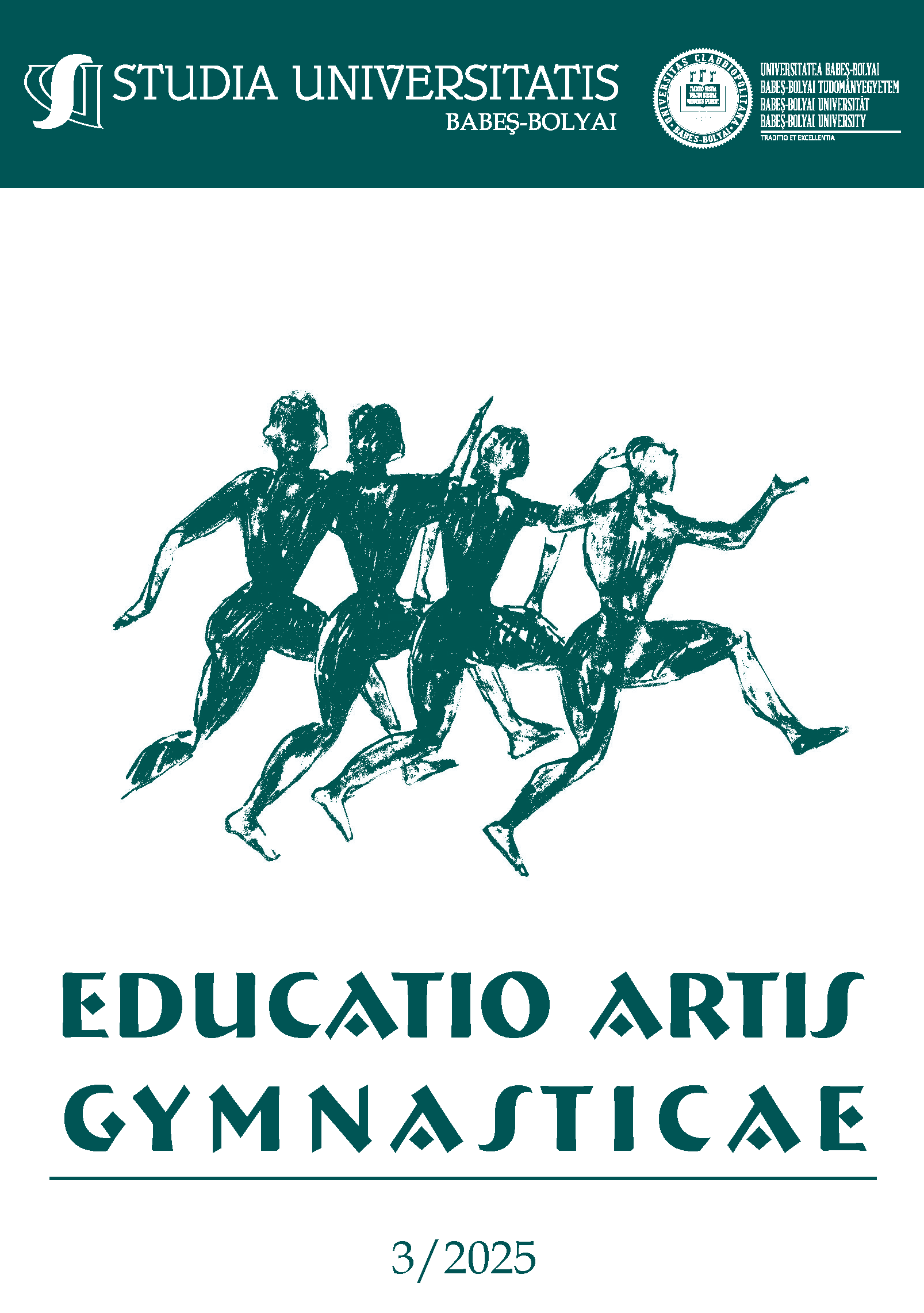Determining the Difference between the Chronological and Biological Age of Athletes Diagnosed with Trigeminal Neuralgia
DOI:
https://doi.org/10.24193/subbeag.70(3).22Keywords:
trigeminal neuralgia, athletes, chronological age, biological ageAbstract
Trigeminal neuralgia induces severe, often intolerable pain in patients—athletes, in this context—that is frequently resistant to currently available therapeutic options. The International Association for the Study of Pain (IASP) defines trigeminal neuralgia as a sudden, typically unilateral, intense, brief, stabbing, and recurring episode of pain in the distribution of one or more branches of the trigeminal nerve. The condition may be caused by vascular compression of the trigeminal nerve, tumor-related processes, or multiple sclerosis. Compression of the nerve itself leads to demyelination, which results in abnormal depolarization and the generation of ectopic impulses. Triggers for pain may include heat, cold, eating, breathing, tooth brushing, shaving, or incidental contact. Once diagnosed by a specialist, magnetic resonance imaging (MRI) is required to confirm or exclude multiple sclerosis. Tumorous processes may also secondarily lead to trigeminal neuralgia. The first-line pharmacological treatment remains carbamazepine. If pharmacotherapy proves ineffective, more invasive interventions such as microvascular decompression, stereotactic radiosurgery (Gamma Knife), percutaneous balloon microcompression, glycerol rhizolysis, and radiofrequency (RF) ablation may be considered. This study is unique in that its sample comprises athletes diagnosed with trigeminal neuralgia. The primary objective is to examine potential differences between their chronological and biological age by analyzing their metabolic age. The findings aim to support and potentially initiate a novel paradigm or theoretical framework concerning the remodeling of biological aging in athletes suffering from trigeminal neuralgia, particularly in the context of optimizing training processes.
Article history: Received 2025 July 18; Revised 2025 October 08; Accepted 2025 October 23;
Available online 2025 November 20; Available print 2025 November 30
References
Apfelbaum, R. I. (2000). Neurovascular decompression: The procedure of choice? Clinical Neurosurgery, 46, 473–498.
Androja, L., Miočić, J., Bilić, Ž., & Komšo, M. (2021). Frequency of peripheral nerve injuries in athletes of certain sports clubs in the city of Zadar. Acta Kinesiologica, 15(1), 127–132. https://doi.org/10.51371/issn.1840-2976.2021.15.1.1
Chong, M. S., Bahra, A., & Zakrzewska, J. M. (2023). Guidelines for the management of trigeminal neuralgia. Cleveland Clinic Journal of Medicine, 90(6), 355–362.* https://doi.org/10.3949/ccjm.90a.22098*
Chudy, D., Dlaka, D., Almahariq, F., Romić, D., Marković, D., & Grahovac, G. (n.d.). Mikrovaskularna dekompresija u supinacijskom položaju za liječenje neuralgije trigeminusa. Medicina.
Dlaka, D. (2007). Prognostički čimbenici i čimbenici ishoda liječenja radiokirurgijom gama nožem bolesnika oboljelih od refraktorne idiopatske neuralgije trigeminusa [Master’s thesis, Hrvatski institut za istraživanje mozga]. Zagreb.
Dionne, R., Newton-John, T., & Zakrzewska, J. M. (2009). Overall management of facial pain. In J. M. Zakrzewska (Ed.), Orofacial pain (pp. 53–68). Oxford University Press.
Donma, O., & Donma, M. M. (2020). Assessment of obesity parameters in terms of metabolic age above and below chronological age in adults. International Journal of Medical and Health Sciences, 14(2), 65–68.
Elguezabal-Rodelo, R., Ochoa-Précoma, R., Vazquez-Marroquin, G., Porchia, L. M., Montes-Arana, I., Torres-Rasgado, E., Méndez-Fernández, E., Pérez-Fuentes, R., & Gonzalez-Mejia, M. E. (2021). Metabolic age correlates better than chronological age with waist-to-height ratio, a cardiovascular risk index. Medicina Clínica (Barcelona), 157(9), 409–417. https://doi.org/10.1016/j.medcli.2020.07.026
Fukuda, H., Ishikawa, M., & Okumura, R. (2003). Demonstration of neurovascular compression in trigeminal neuralgia and hemifacial spasm with magnetic resonance imaging: Comparison with surgical findings in 60 consecutive cases. Surgical Neurology, 59, 93–100. https://doi.org/10.1016/S0090-3019(02)01014-5
Lopez, B. C., Hamlyn, P. J., & Zakrzewska, J. M. (2022). Stereotactic radiosurgery for primary trigeminal neuralgia: State of the evidence. Acta Clinica Croatica, 61(Suppl. 2), 100–106.
Machado, A., Ogrin, M., Rosenow, J. M., & Henderson, J. M. (2007). A 12-month prospective study of Gasserian ganglion stimulation for trigeminal neuropathic pain. Stereotactic and Functional Neurosurgery, 85, 216–224.
Merskey, H., & Bogduk, N. (1994). Classification of chronic pain: Descriptions of chronic pain syndromes and definitions of pain terms (2nd ed.). IASP Press.
Miočić, J., & Komšo, M. (2020). Važnost tjelesnog vježbanja za osobe s dijagnosticiranom multiplom sklerozom. Zbornik Sveučilišta Libertas, 5(5), 27–34. https://doi.org/10.46672/zsl.5.5.2
Perrudin, F. (2005). Civilizacije svijeta. Naša djeca.
Pisaruk, A., Shatilo, V., Shchehlova, I., Naskalova, S., & Mechova, L. (2021). Model of human metabolic age. Problems of Endocrine Pathology, 77(3), 71–75.
Radoš, M. (2004). Trigeminal neuralgia and recommendations for future reports. Journal of Neurology, Neurosurgery & Psychiatry, 75, 1019–1024.
Scrivani, S. J., Mathews, E. S., & Maciewicz, R. J. (2005). Trigeminal neuralgia. Oral Surgery, Oral Medicine, Oral Pathology, Oral Radiology, and Endodontology, 100(5), 527–533. https://doi.org/10.1016/j.tripleo.2005.05.044
Tolle, T., Dukes, E., & Sadosky, A. (2006). Patient burden of trigeminal neuralgia: Results from a cross-sectional survey of health state impairment and treatment patterns in six European countries. Pain Practice, 6, 153–160.
Tomasović, S. (2019). Nuralgije kranijalnih živaca. Medicus, 28(1), 71–75.
Vásquez-Alvarez, S., Bustamante-Villagomez, S. K., Vazquez-Marroquin, G., Porchia, L. M., Pérez-Fuentes, R., Torres-Rasgado, E., & Gonzalez-Mejia, M. (2021). Metabolic age, an index based on basal metabolic rate, can predict individuals that are high risk of developing metabolic syndrome. High Blood Pressure & Cardiovascular Prevention, 28(3), 263–270.
Xu, R., Xie, M. E., & Jackson, C. M. (2021). Trigeminal neuralgia: Current approaches and emerging interventions. Journal of Pain Research, 14, 3437–3463. https://doi.org/10.2147/JPR.S314372
Downloads
Published
How to Cite
Issue
Section
License
Copyright (c) 2025 Studia Universitatis Babeş-Bolyai Educatio Artis Gymnasticae

This work is licensed under a Creative Commons Attribution-NonCommercial-NoDerivatives 4.0 International License.



